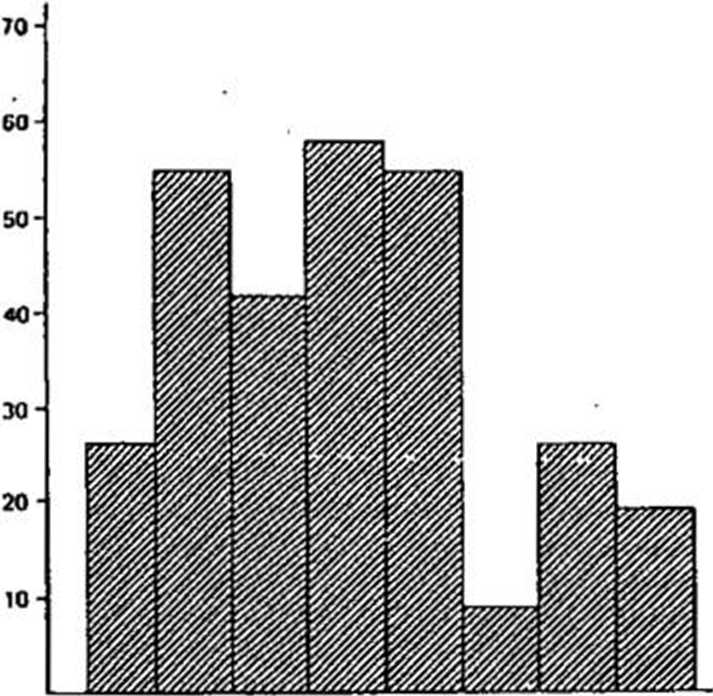7578409672

Fig. 1 Age distribution of 73 butchers in western Sweden 1981

Neck £ łbowi Low back Kneei
ShoukJm Wmw Hipi Ankiet
Fig. 2 Oistribution of bodily disorders among 73 butchers in western Sweden 1981
they considcrcd (o cause these loads. The butchers were instructed lo judgc the loads irrespeclire of whelher they experienced any pain or not. To gńre a generał picture of the butchers’ working conditions, the ąuestionnaire also included ąuestions about psychologia! strains, injury risks and physical loads due to other factors such as noise, lighting, temperaturę, etc.
The butchers* workplaces were visited on several occasions in order to investigate the working tasks and to make an ergonomie review of these tasks. In judging the load on the body during work, biomechanical factors were taken into consideration; the weight of the handled materiał, the distance between the body and the burden,and a rough estimate of the resistance and force required when cutting meat. Also the degree of flexibility of the working posturę and the degree of monotony in repetitive movements were considered. The butchers* work was described and documented in a protocol and by photography.
A possible connection between workload and bodily disorders was investigated. The distributions of disorders and discomfort were compared with the subjectively experienced loading on different parts of the body, and with the type of work — i e, dynamie or stalic work, repetitive movements and traruportation of materiał - both as specified by the butchers and accordingto the observations madę during the workplace studies. In this way it was possible to arrange the work tasks according to the workload and freąuency of disorders. High workload on a body part that had a high frequency of disorder was considered sufficient evidence to cali for ergonomie improvements of the work situations in which high loads occuned.
Results of the questionnaire
The ąuestionnaire was distributed to aJl butchers at the companies, and 73 butchers (88%) answered the ąuestions. The results showed that the number of young butchers was high and very few were near the age of retirement; there was only one hufcher over 60 years old and 50% were less than 30 years old (Fig. 1). The freąuency of disorders was high among both older and younger butchers.
Pain from any part of the body was cxperienced by 92% (Fig. 2). Most common was pain from the hands and wrists (about 60%) and from the shoulders and Iow back (55%). Pain from the elbows occurred in 40%. Almost 80% had pain from morę than one area of the body, and the most freąuent combination was pain from the neck and one or morę joints of the arm. About 50% of lhose with disorders had consulted a doctor, and about the same number had been on sick leavc at least once. Fourteen percent had been forced todccrease their ratę of work due to their probierni. Morę than half of the butchers claimed that they felt fatigue during or after work (Fig. 3).
According to the butchers* opinions, the shoulders, hands, elbows and Iow back were the areas of the body which had the largest load. Almost 80% considered the shoulders and hands to be heavily loaded and morę than 60% thought that the Iow back was heaviJy loaded during work (Fig. 4).
with the knife were factors which were experienced as troublesome (Fig. 5). Also the high ratę of work and the monotony were factors particularły mentioned.
Working routines in cutting beef and pork
The room w herc the work was being done was usually very noisy. Noise and the low temperaturę were judged as factors of high work stress. The passibiiity of slipping or stumbling and, of course, also the risk of injuring oneself
The carcass of an ox is normally dirided into four paru while that of a pig is divided into two paru before it arrives at the butcher to be cut into pieces. The procedurę of cutting these parts into smaller details involves different tasks and the
44 Applied Ergonomici March 1987
Wyszukiwarka
Podobne podstrony:
80 (129) 154 The Viking Age in Denmark Figurc 44 Distribution of Arabie coins in a sam ple of north-
81 (117) 156 The Viking Age in Denmark Figurę 46 Distribution of Arabie coins in a samplc of castcrn
82 (123) 158 The Viking Age in Denmark Figurc 48 Distribution of Arabie coins in an carly tenth-cent
83 (120) 160 The Viking Age in Denmark Figurc 50 Distribution of Arabie coins in a late tenth-centur
DSC07875 (3) Fig. 1. Distribution of inland dunes in Poland 1 - dunes and sand areas (Galon 1958), 2
P1190372 Fig. 4. Distribution of ihc hucchero in Etrurio. Meditemncan and bcyond (afler von Hue 1989
148H. Pondel Shamsham S., Roszyk E. Distribution of Selected Metals in the Profiles of Culti vated S
S. Jewtuchowicz Fig. 18. Distribution of boulder-clay horizons 1 — no boulder-clay, 2 — one horizon
DSC07081 Fig. 141. The same place today (October 2°°8);; • ....... Fig. 142. View
DSC07081 Fig. 141. The same place today (October 2°°8);; • ....... Fig. 142. View
DSCI3125 so18. Formulate the rule(s) responsible for the distribution of IM variants in the data
Figurę 1-2.Distribution of Armored Vehicles in an Armored Combat Brigade(Number of
image008 Fig. 4. Possible reconstructions of the tempie in Old Uppsala, drawings based cm: A.-C. Sch
clinical immuno final1 02 /8. The most common form of primary glomerulonephritis in western countrie
DSCN6550 (2) Distribution of viscerai leishmaniańs in Africa due to Leishmemia donovani donorani and
więcej podobnych podstron